Monastic vineyards stand at the crossroads of spirituality and agriculture, offering a unique window into the legacy of winemaking within religious communities. The rich tradition of monks and nuns cultivating grapevines dates back to medieval times when monasteries served as centers of knowledge, preserving viticulture through periods of turmoil and social upheaval.
Today, these historical vineyards symbolize not only a deep-rooted history but also the pursuit of winemaking as a form of monastic life and devotion.
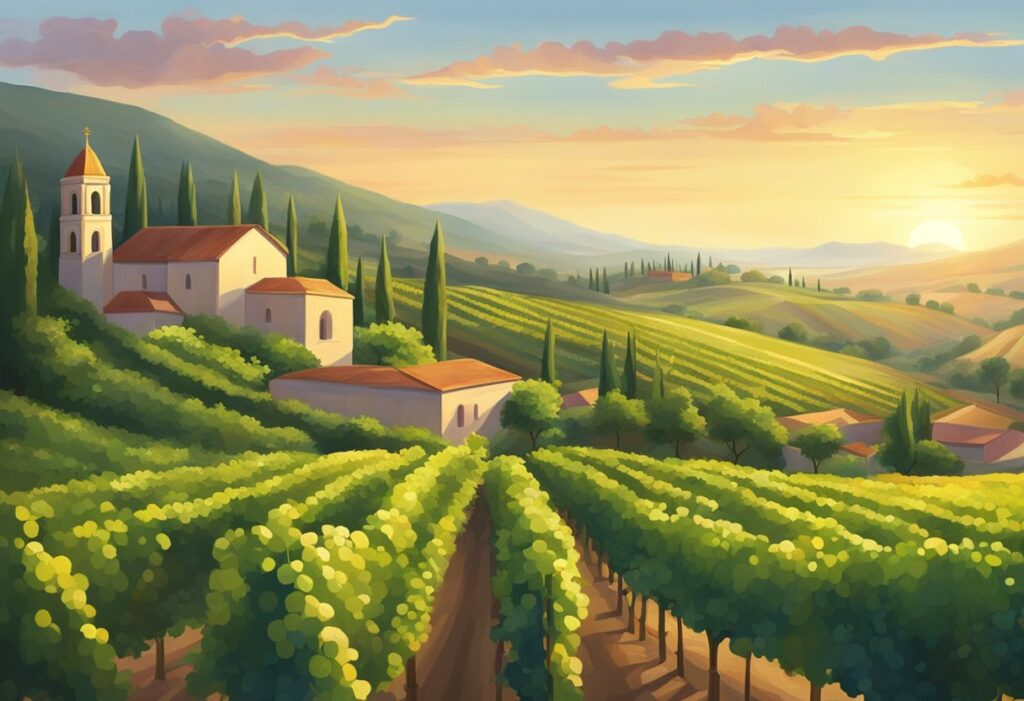
These hallowed grounds are custodians of ancient techniques, many of which have been refined and passed down through the centuries. Monastic orders played a vital role in the development of wine regions, discovering the importance of “terroir” and innovating ways to enhance the wine’s quality.
Ensconced within the serene monastic walls, the vineyards carry forward the ethos of authenticity and reverence for nature, producing wines that reflect a deep connection between the land, the spiritual life of their caretakers, and Christianity’s cultural narrative woven through wine history.
Key Takeaways
- Monastic vineyards are a fusion of religious devotion and historical viticulture.
- Monks contributed significantly to the refinement of winemaking and viticultural techniques.
- These vineyards uphold the authenticity and heritage of winemaking within Christian traditions.
The Monastic Tradition and Wine
For centuries, monks and nuns have played a pivotal role in the cultivation of vineyards and the production of wine. Particularly, the Benedictine, Cistercian, and Carthusian orders have developed unique wine-making traditions within their communities.
The Benedictines, known for their diligence, brought profound changes to viticulture during the medieval period. Your understanding of European wine is incomplete without acknowledging their contribution to enhancing wine quality and storage.
The Cistercian monks, seeking a simpler way of life, brought innovation to winemaking by introducing rigorous record-keeping. They documented soil types, harvest techniques, and grape varietals, thereby laying the foundation for the concept of terroir. Their meticulous approach to winemaking has yielded wines of exceptional quality that bear their legacy.
Carthusian monks, while more contemplative in their lifestyle, have also cultivated vineyards. Although fewer in number, their vineyards are known to produce wines with a distinct character, reflective of their secluded and prayerful existence.
You can still visit operational monasteries where these practices continue. The monks and nuns of these monastic communities maintain the vinicultural traditions, preserving the rich history and expertise that has been passed down through generations. Through their unwavering commitment, they exemplify the time-honored bond between faith and the art of winemaking.
Historical Development of Vineyards
The history of vineyards is deeply entwined with monastic endeavors, particularly through the Middle Ages, when vine cultivation and winemaking were significantly advanced by monks.
From Ancient Rome to Monastic Care
Wine history stretches back to times before the Romans, but it was within the Roman era that the foundations for modern viticulture were laid. As viticulture spread across Europe, Roman techniques paved the way for a rich tradition of wine production. Your understanding of this period is further enhanced by knowing about Roman contributions to ancient wine production.
With the fall of Rome, monastic communities emerged as custodians of winemaking knowledge. The Church played a crucial role in maintaining vineyards, and places like France became centers of monastic winemaking. The Clos de Vougeot, a vineyard in Burgundy established by Cistercian monks in the 12th century, exemplifies the monastic influence on viticulture.
Medieval Expansion and Wine Trade
During the Middle Ages, monastic vineyards flourished. Monasteries like those in the regions now known as France, had extensive vineyards and were at the forefront of wine trade. Your appreciation of medieval vineyards is complemented by insights into Neolithic wine-making, highlighting a tradition that the monks inherited and refined.
It wasn’t just about producing wine for religious ceremonies; it was also a serious economic pursuit. Monks were instrumental in trading wine, utilizing vessels such as amphorae to transport it. Their efforts helped to spread wine culture throughout Europe.
Legacy of Monastic Winemaking
The techniques and meticulous care that monks brought to viticulture laid the groundwork for the quality winemaking standards followed to this day. They were pioneering horticulturists, selecting grape varieties that matched the soil and climate of their lands.
The knowledge and experience accrued over the centuries were passed down and expanded upon, which you can see in the practices of modern wineries that trace their roots to those early monastic sites—exploring the earliest wineries gives an appreciation for the monastic contributions to this enduring legacy.
Viticulture and Winemaking Techniques
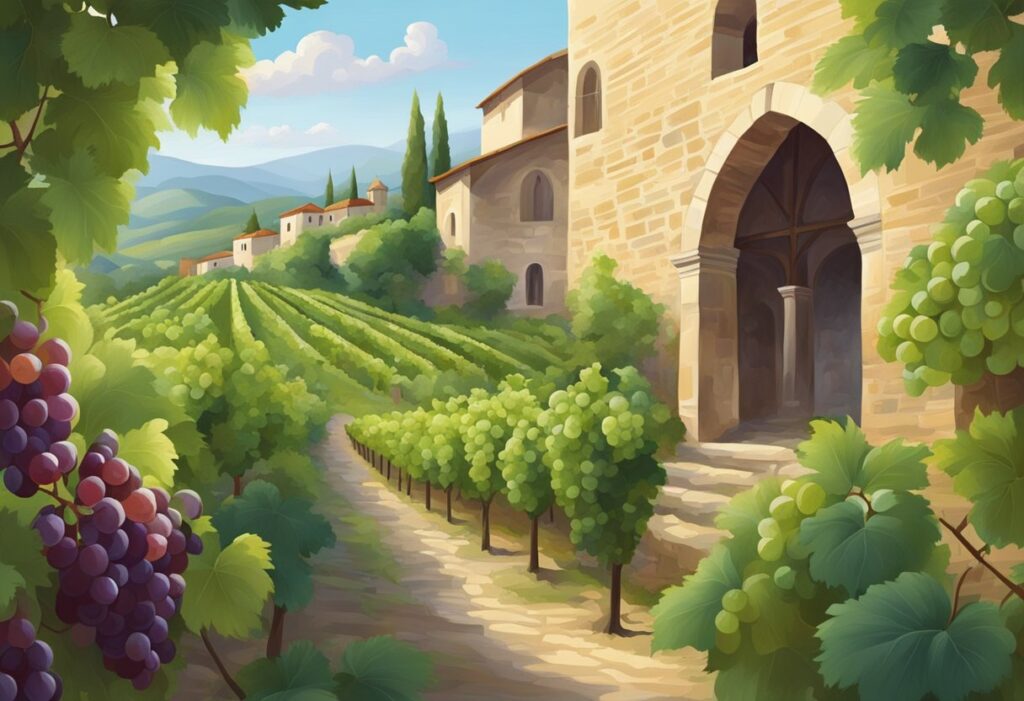
In this section, you will discover the enduring traditional viticultural practices that have shaped the world of wine, as well as the innovative strategies driving modern winemaking forward.
Traditional Viticultural Practices
Your journey through the vineyards begins with an understanding of viticulture, the cultivation of grapevines. Pruning is a vital traditional skill, shaping the vines to ensure healthy growth and optimal fruit quality. The techniques of pruning vary from the meticulous cane pruning to spur pruning, each with its specific impact on vine balance and grape yield.
The grape harvest is another cornerstone of traditional viticulture. Historically, monks in regions like Burgundy honed the practice of carefully selecting the right time to pick grapes, which is pivotal for achieving the desired balance of sugar, acidity, and tannins in the finished wine.
Innovation in Winemaking
Moving into the cellar, winemaking processes have evolved from the purely empirical to a blend of art and science. Temperature control during fermentation is a relatively modern innovation that allows winemakers to steer the production of certain flavor profiles and maintain consistency.
The advent of controlled malolactic fermentation has given winemakers greater control over the texture and flavor complexity of the wine. This technique softens the wine by converting sharper malic acid into softer lactic acid, adding a creamy, buttery dimension where desired.
Both old and new methods contribute to the overarching goal of wine production: crafting a beverage that reflects both the terroir of the vineyard and the vision of the winemaker. Advances in technology and the refinement of age-old techniques continue to shape the future of this ancient craft.
Regions and Notable Monastic Vineyards
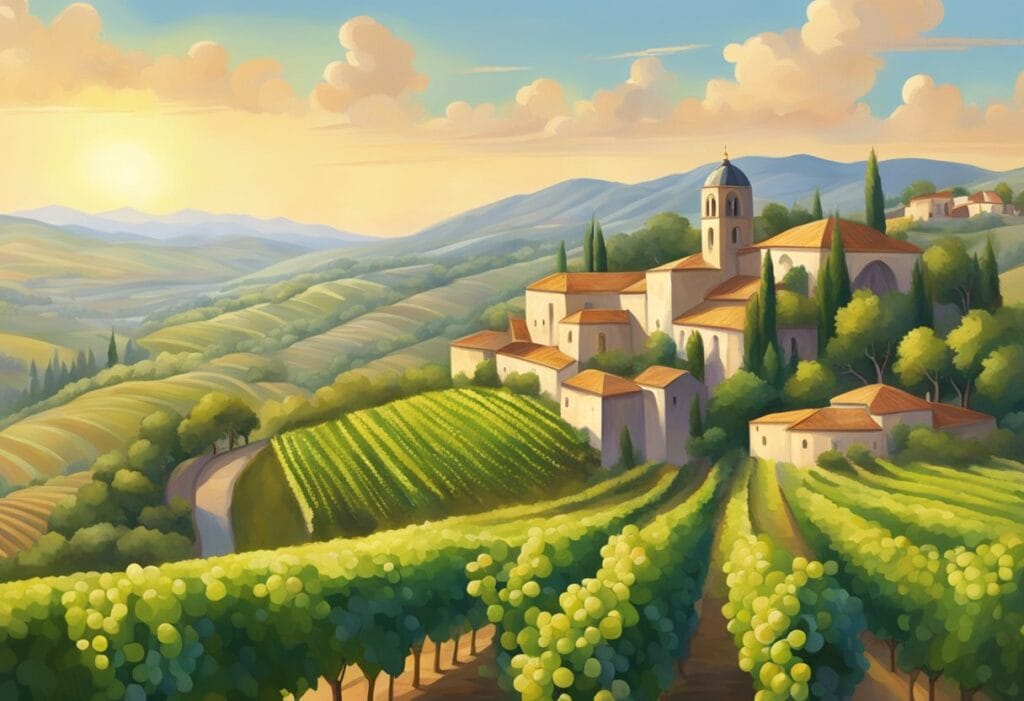
You’ll discover that Europe’s history with wine is deeply intertwined with monastic orders, who not only preserved and cultivated winemaking traditions but were also responsible for pinpointing some of the best terroirs. Many revered vineyards you know today were originally developed by monks.
Burgundy: A Focal Point of Monastic Winemaking
In Burgundy, monastic influences date back to the Medieval era, with monasteries like the Cistercians and Benedictines playing a pivotal role in developing the region’s winemaking. The Clos de Vougeot vineyard, a grand cru vineyard in the Côte de Nuits section of Burgundy’s larger Côte de Vin, was established by Cistercian monks and remains a landmark of monastic winemaking heritage.
You can trace the quality of Burgundy wines to these meticulous monks, who recognized the importance of terroir—the unique conditions where vines are grown that give Burgundy wines their distinctive character.
Other French Monastic Vineyards
Beyond Burgundy, you’ll find the Loire Valley, the Rhône Valley, and Provence, all with monastic vineyard traditions. Take the Abbaye du Petit-Quincy estate, which boasts a history of wine production by the monks of the Cistercian abbey of Notre-Dame de Quincy, or the vineyards of Alsace, with a viticultural legacy that spans over a thousand years.
Bordeaux and Champagne also have monastic roots, though less pronounced compared to Burgundy, yet these regions’ contributions to the winemaking techniques and the cultivation of certain grape varieties are essential chapters in the narrative of monastic vines.
International Monastic Viticulture
The tradition of monastic winemaking didn’t stay confined to France. Venturing through Europe, you’ll find other countries like Austria, where the Kremstal wine region bears the marks of a thousand-year-old winemaking tradition, with vineyards surrounding the historic town of Krems.
Monastic orders across the continent have honed their craft over centuries, influencing wine production in regions far from the borders of France, ensuring that the heritage of monastic viticulture continues to thrive in the modern age.
Grape Varieties and Wine Styles
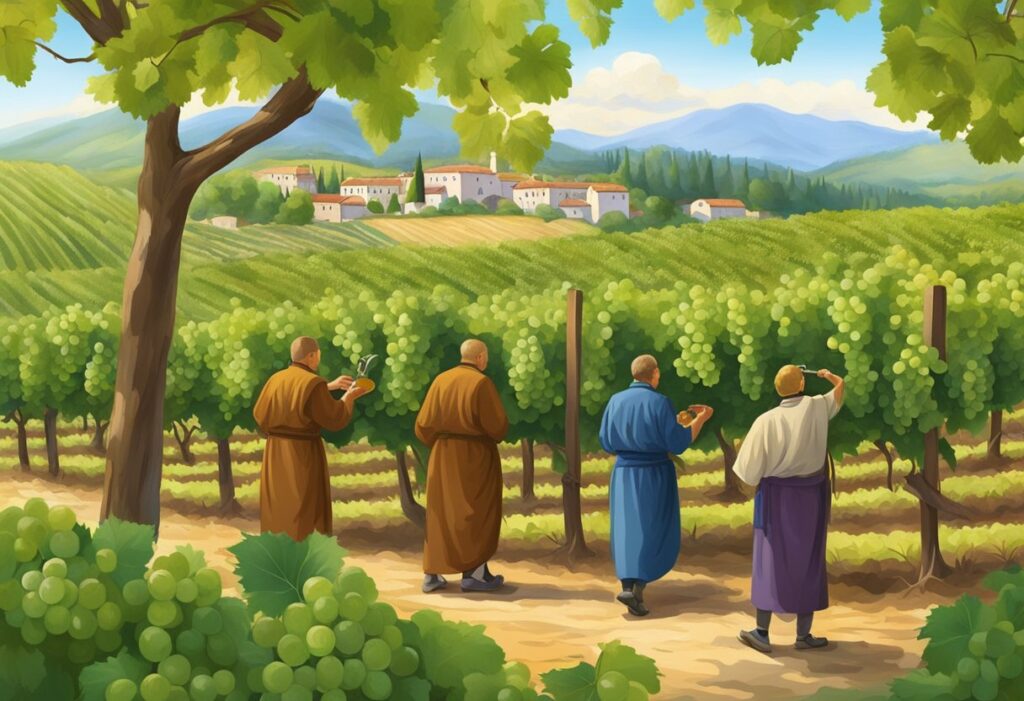
Monastic vineyards are renowned for their meticulous cultivation of grape varieties, producing wines with distinctive character and quality. Your understanding of the grape varieties and the resulting wine styles is fundamental to appreciating monastic wines.
White Grape Varieties
Chardonnay and Roussanne are key white varieties grown in monastic vineyards, often yielding wines that range from light and crisp to rich and full-bodied. Specifically, Chardonnay thrives in the ancient soils of regions like Burgundy.
- Chardonnay: Known for its versatility and ability to reflect terroir. You can expect flavors from apple and citrus in cooler regions to tropical notes in warmer areas.
- Roussanne: Delicate and aromatic, producing deeply flavored wines, often with a hint of honeysuckle.
Red Grape Varieties
Syrah, Grenache, and Pinot Noir are among the most cultivated red grape varieties in these vineyards, where they create a spectrum of wines, from the intensely flavorful Côtes du Rhône to more subtle varieties.
- Syrah: Offers robust, tannic wines with dark fruit flavors and a peppery finish. It’s a cornerstone in blends from the Rhône.
- Grenache: Often yields juicy and berry-flavored wines with soft tannins; it’s a staple grape in many blended red wines, contributing to their fleshy character.
- Pinot Noir: A grape that brings elegance and complexity, often found in cooler climes like the Loire valley; it’s celebrated for its expressions of red fruit and earthy undertones.
Unique Regional Varietals
Beyond the well-known varieties, monastic vineyards also nurture unique regional varietals. These grapes might not be globally recognized, but they contribute to the diversity and richness of monastic wine portfolios.
- Loire Valley: Notable for its exceptional expressions of Pinot Noir and other unique local grapes, yielding wines from mineral-driven whites to velvety reds.
- Sweet Wine: Monastic vineyards leverage grapes like Grenache for sweet wines, concentrating their sugars to create wines that are both lush and elegantly sweet.
Your exploration of these vineyards can lead you to discover wines that reflect the deep historical significance and the dedicated craftsmanship of monastic viticulture.
Challenges Faced by Monastic Vineyards
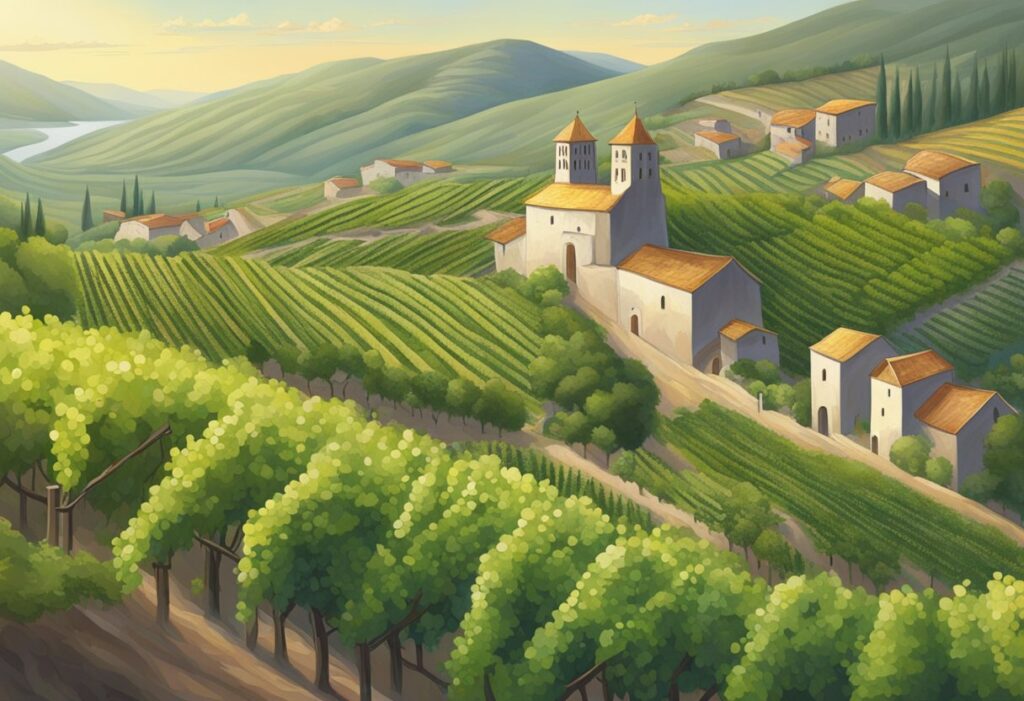
Monastic vineyards have encountered various adversities throughout history, from ancient pests to contemporary environmental concerns.
The Phylloxera Epidemic
Phylloxera, a tiny aphid-like insect, posed a catastrophic threat to wine production in the late 19th century. The pest decimated European vineyards, including those run by monks, leading to drastic measures to save the legacy of monastic wine production. Rootstock from resistant American vines became the ultimate solution, but not before profound damage was inflicted.
Modern Day Challenges
Today, monastic vineyards must navigate a myriad of modern challenges. Foremost among these is climate change, which is introducing volatility in weather patterns, affecting grape yield and quality. You’ll find monasteries adapting viticulture practices and exploring new grape varieties resilient to these changes.
Additionally, they must also address evolving consumer preferences and competition in a global market. Monks have historically relied on their unique traditions and practices, like those seen at New Clairvaux Vineyards, to differentiate themselves in the crowded wine industry.
Monastic wine producers continue to balance the integrity of their time-honored methods with the need for innovation to overcome these contemporary hurdles.
Cultural and Religious Significance
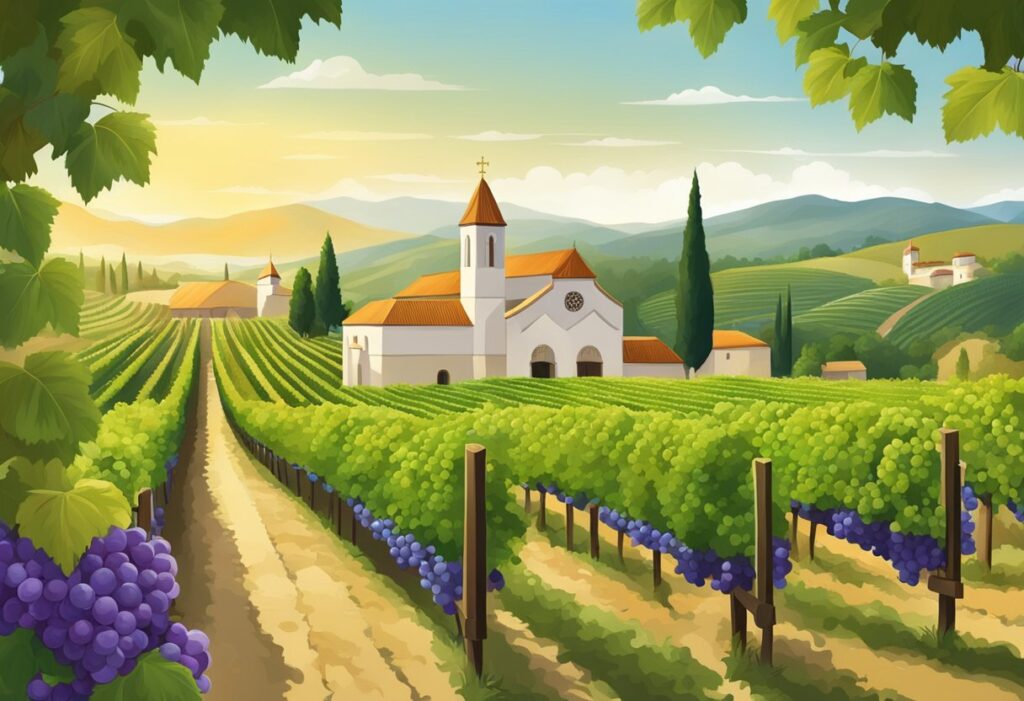
Monastic life has long been intertwined with viticulture, particularly within Christianity. Monks and nuns engaged in winemaking not only for sustenance but also as a spiritual practice. Your understanding of this relationship deepens when considering that, for centuries, the Catholic Church has used wine during the Eucharist, symbolizing the blood of Christ.
Traditionally, grape harvest and winemaking in monasteries were seen as acts of prayer and reflection, signifying the connection between divine creation and human craft. This integration of work and worship emphasizes the monastic influence in maintaining and perfecting viticultural techniques through the ages. In many regions, monastic communities were pioneers in developing the wine industry, improving cultivation methods and enhancing wine quality.
Moreover, viticulture held a prominent place in religious observances and feast days. During the Roman era, festivals like the Bacchanalia celebrated the god Bacchus and illustrated wine’s cultural relevance. Similarly, the Greek deity Dionysus was honored for his association with wine, fertility, and rebirth, exemplifying its significance in ancient religious traditions.
In summary, wine is deeply rooted in monastic tradition and Christian rites. Its production by monks and nuns is more than an agricultural task—it’s an act deeply embedded with cultural and religious importance, contributing to your appreciation of wine beyond its physical taste.
Conservation and Tourism
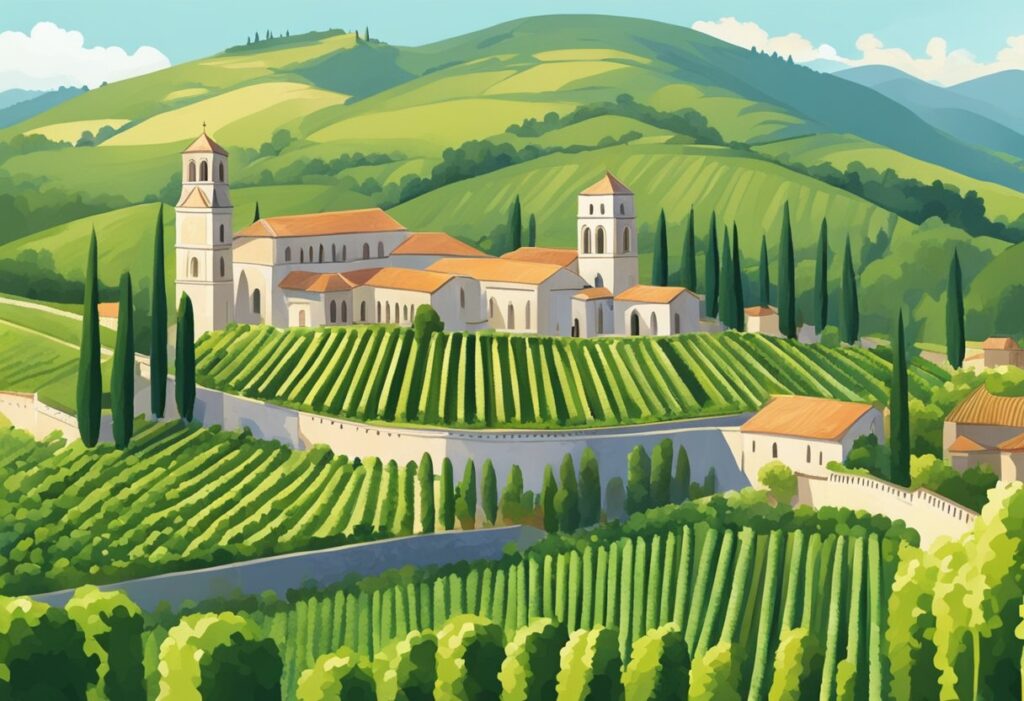
In monastic vineyards, conservation and tourism are intertwined, reflecting France’s commitment to heritage and the authenticity of winegrowing.
Preservation of Monastic Winegrowing Heritage
You can observe meticulous preservation efforts in French monastic vineyards, where the rich winegrowing heritage dates back centuries. These vineyards maintain traditional methods while integrating sustainable practices to protect biodiversity.
They serve as exemplars of conserving cultural landscapes and showcase how heritage can coexist with modern demands. In such settings, the authenticity of the wine is paramount, often leading to wines with unique profiles, desirable for both local consumption and export.
Wine Tourism in Monastic Settings
Wine tourism in monastic settings offers you the chance to experience wine production in a historically rich context. The serenity of monastic vineyards attracts visitors seeking an authentic connection with the land and its longstanding traditions.
The tours and tastings at these venues are not mere transactions but deeply immersive experiences that weave together spirituality, history, and viticulture. Additionally, your visit contributes to the local economy, ensuring the longevity of these French vineyards and the traditions they uphold.
Modern Monastic Winemaking
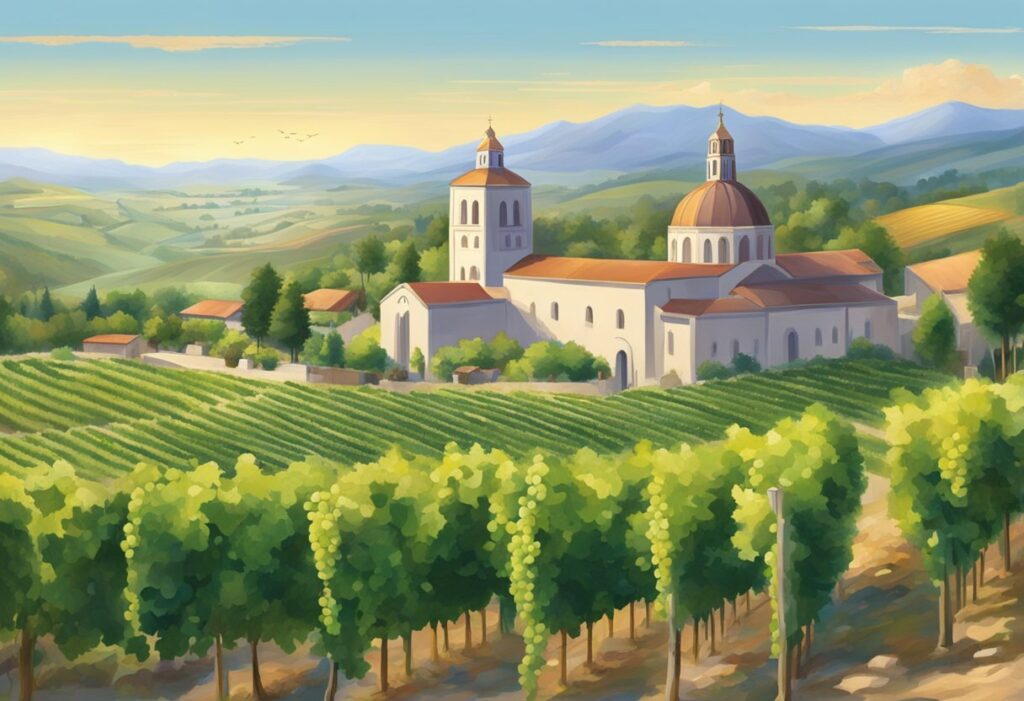
Monastic winemaking has evolved, yet it stays true to its historical roots of meticulous viticulture and careful winemaking. The practices refined over centuries by monastic communities continue to influence winemaking within and beyond monastic vineyards.
Contemporary Monastic Practices
You’ll find that many monastic orders have maintained their long-standing traditions in winemaking, while incorporating contemporary techniques to improve the quality and sustainability of their vineyards. For example, the Trappist-Cistercian monks at the New Clairvaux Vineyard uphold a legacy of viticulture dating back nearly a thousand years, partnering with skilled winemakers to produce wines that reflect both their heritage and modern advancements.
- Viticulture: Monks utilize a blend of age-old wisdom and modern knowledge to cultivate grapes.
- Winemaking: Careful attention to detail ensures that the process from grape to bottle maintains the monastic standard of excellence.
The Future of Monastic Winemaking
The future of monastic winemaking looks to balance tradition with innovation. Investments in sustainable practices show a commitment to eco-friendly viticulture and could define the next chapter of monastic wine. Your understanding of wines like French wine may be enriched by this historic yet forward-looking approach. Monastic vineyards, often located in regions with a profound wine heritage, are poised to continue their influential role in the winemaking world.
Conclusion
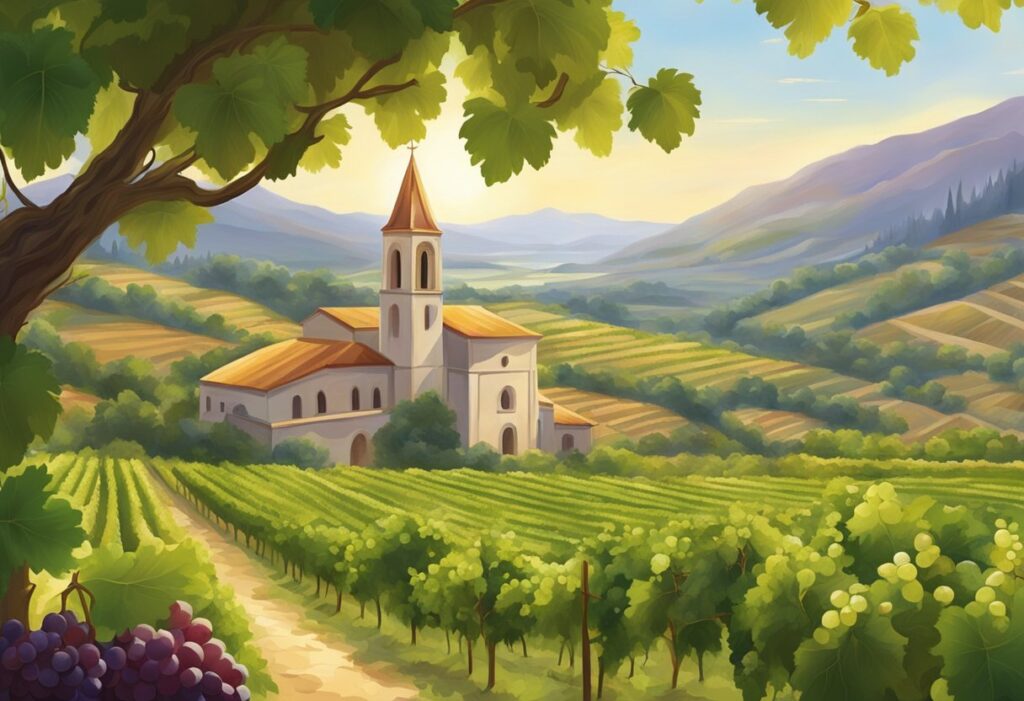
Monastic vineyards have been a critical component of winemaking history, particularly in France. These vineyards didn’t just supply wine; they were centers of agricultural innovation and spiritual discipline. As you explore the relationship between monastic life and wine production, it’s evident that the commitment to crafting wine was fused with a pursuit of religious devotion.
In France, the meticulous care of grapevines by monks laid the groundwork for some of the world’s most esteemed wine regions. The Burgundy and Champagne areas particularly owe their reputations to the initial efforts of these monastic communities. Through their understanding of terroir and vineyard management, monks were able to produce wines of exceptional quality.
The process of winemaking within monasteries was not merely an economic activity; it was a spiritual one as well. The rhythm of monastic life, which balanced prayer and labor, was the perfect environment for the patient and attentive nature required in winemaking. This included pruning, harvesting, and fermenting the grapes with careful oversight.
Today, some monastic vineyards still operate, preserving ancient traditions while offering a unique testament to the history of winemaking. You can see their influence not only in the wines produced but also in the cultural landscape, where these monastic properties are appreciated for their contributions to both the sacred and the secular world.
The value of these historical vineyards extends beyond just the bottles of wine they produce; it lies in their ability to connect you to a rich past filled with devotion, craftsmanship, and the enduring legacy of monastic wine production.

